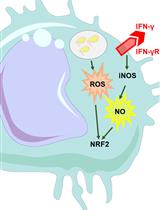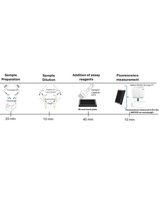- EN - English
- CN - 中文
Measuring Oxidative Stress in Caenorhabditis elegans: Paraquat and Juglone Sensitivity Assays
秀丽隐杆线虫中的氧化胁迫测定:百草枯和胡桃酮敏感性分析法
发布: 2017年01月05日第7卷第1期 DOI: 10.21769/BioProtoc.2086 浏览次数: 14943
评审: Jyotiska ChaudhuriMichael EnosAnonymous reviewer(s)

相关实验方案

使用荧光酶标仪连续测量受细菌感染的骨髓源性巨噬细胞中活性氧的生成
Natascha Brigo [...] Christa Pfeifhofer-Obermair
2023年02月05日 2400 阅读
Abstract
Oxidative stress has been proposed to be one of the main causes of aging and has been implicated in the pathogenesis of many diseases. Sensitivity to oxidative stress can be measured by quantifying survival following exposure to a reactive oxygen species (ROS)-generating compound such as paraquat or juglone. Sensitivity to oxidative stress is a balance between basal levels of ROS, the ability to detoxify ROS, and the ability to repair ROS-mediated damage.
Keywords: Oxidative stress (氧化胁迫)Background
A number of approaches have been used to test sensitivity to oxidative stress in Caenorhabditis elegans including exposure to paraquat, juglone, t-BOOH, arsenite, H2O2, or hyperbaric oxygen(Keith et al., 2014). All of these assays serve to increase the levels of ROS in the worm to a point where survival is decreased. The assays differ in the primary type of ROS that the worm is exposed to (e.g., superoxide, hydrogen peroxide), the rate of exposure (acute versus chronic) and the subcellular compartment believed to be most affected (e.g., paraquat increases superoxide levels primarily in the mitochondria (Castello et al., 2007). Based on these differences, it is possible that a particular strain of worm exhibits increased sensitivity or increased resistance to oxidative stress in one assay, but does not show a difference in another assay. It is also possible that a strain of worms is sensitive to oxidative stress at one age, but resistant to that same form of oxidative stress at a different age. Thus, to obtain a full understanding of sensitivity to oxidative stress in a particular strain it is necessary to use multiple assays at different time points.
Materials and Reagents
- Petri dishes 60 x 15 mm 500/cs (Thermo Fisher Scientific, Fisher Scientific, catalog number: FB0875713A )
- Petri dishes 35 x 10 mm 500/cs (Thermo Fisher Scientific, Fisher Scientific, catalog number: FB0875711YZ )
- Autoclave tape
- Aluminum foil
- 99.95% Platinum, 0.05% Iridium Wire (3 ft/pk) (Tritech Research, catalog number: PT-9901 )
- OP50 E. Coli bacteria (University of Minnesota, C. elegans Genetics Center, N/A)
- Experimental and control C. elegans strains (University of Minnesota, C. elegans Genetics Center, N/A)
- Eggs from experimental and control C. elegans strains
- Methyl viologen dichloride hydrate (paraquat) (Sigma-Aldrich, catalog number: 856177 )
- FUdR (5-fluoro-2’-deoxyuridine) (Sigma-Aldrich, catalog number: F0503 )
- 5-hydroxy-1,4-naphthoquinone (juglone) (Sigma-Aldrich, catalog number: H47003 )
- 100% ethanol
- Sodium chloride (NaCl) (Sigma-Aldrich, catalog number: S7653 )
- Bacto peptone (BD, catalog number: 211677 )
- Agar (Sigma-Aldrich, catalog number: A1296 )
- Cholesterol (Sigma-Aldrich, catalog number: C8667 )
- Magnesium sulfate heptahydrate (MgSO4·7H2O) (Sigma-Aldrich, catalog number: M1880 )
- Calcium chloride dihydrate (CaCl2·2H2O) (Sigma-Aldrich, catalog number: C3881 )
- Potassium phosphate dibasic (K2HPO4) (Sigma-Aldrich, catalog number: P2222 )
- Potassium phosphate monobasic (KH2PO4) (Sigma-Aldrich, catalog number: P5655 )
- Tryptone (Sigma-Aldrich, catalog number: T7293 )
- Yeast extract (Sigma-Aldrich, catalog number: 70161 )
- 0.5% cholesterol (see Recipes)
- 1 M MgSO4 (see Recipes)
- 1 M CaCl2 (see Recipes)
- KPI (see Recipes)
- Nematode growth medium (NGM) (see Recipes)
- 1 M paraquat (see Recipes)
- 3.33 M paraquat (see Recipes)
- 0.1 M FUdR stock solution (see Recipes)
- Juglone stock solution (12 mM) (see Recipes)
- 2 YT medium (see Recipes)
Equipment
- Erlenmeyer flask (Thermo Fisher Scientific, Fisher Scientific, catalog number: FB5006000 )
- M50 stereomicroscope (Leica, model: 10450154 )
- Pipetor (Gilson, catalog number: F167300 )
- Autoclave (Tuttnauer, model: 6690 )
- Stirring hotplate (Corning, catalog number: 6795-620 )
- Centrifuge (Eppendorf, model: 5430 )
- Refrigerated incubator (Thermo Fisher Scientific, Thermo scientificTM, model: 51028064 ; 37-20)
- Bunsen burner (Humbolt, catalog number: H5870 )
Software
- GraphPad Prism software (we use Version 5.01)
Procedure
文章信息
版权信息
© 2017 The Authors; exclusive licensee Bio-protocol LLC.
如何引用
Senchuk, M. M., Dues, D. J. and Van Raamsdonk, J. M. (2017). Measuring Oxidative Stress in Caenorhabditis elegans: Paraquat and Juglone Sensitivity Assays. Bio-protocol 7(1): e2086. DOI: 10.21769/BioProtoc.2086.
分类
生物化学 > 其它化合物 > 活性氧
您对这篇实验方法有问题吗?
在此处发布您的问题,我们将邀请本文作者来回答。同时,我们会将您的问题发布到Bio-protocol Exchange,以便寻求社区成员的帮助。
Share
Bluesky
X
Copy link











